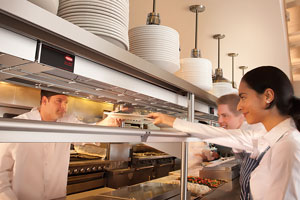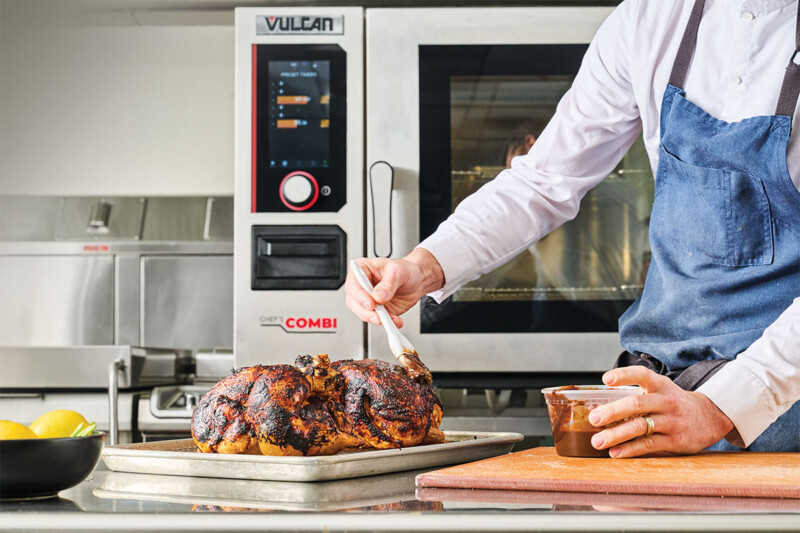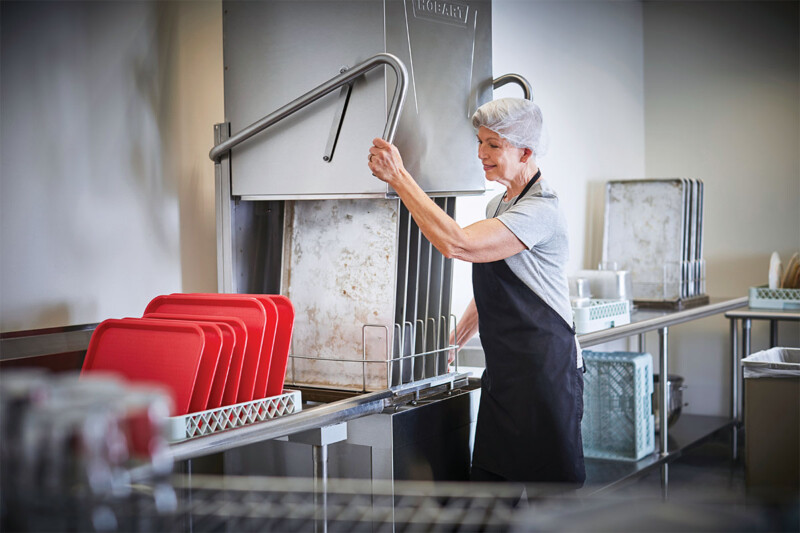
Biting into a hot, crispy French fry is a comfort food experience most people crave. The difference between a fry that’s mouth-watering vs. a soggy, greasy mess, in most instances comes down to temperature. Foodservice operators know that as much as variety and flavor play a pivotal role, it’s just as important to serve hot foods hot and cold foods cold, not only for food safety reasons but also to ensure satisfied customers. Heat strips and lamps play an important role in executing a good experience, whether the operation is a buffet, a cafeteria, a quick-service or a full-service restaurant. Thanks to the wide variety of options, styles and colors, and some new innovations in the category, it’s easier than ever to find the right equipment for each application.
Heat lamps are commonly used to keep plated food warm for short periods of time until it’s taken to the customer. Heat lamps help already hot foods stay hot, holding proper, safe temperatures for a limited amount of time. How long and how hot the food will hold depends on the wattage and space between the food and the lamp and environmental considerations such as drafts and the ambient temperature of the restaurant. The starting temperature of the food itself and its density or ability to retain heat factor in as well.
Generally, for a standard 250W bulb, lamps should hang about 8 in. above the plate to keep the food at about 140°F. Upgrading to a 375W bulb allows the distance to stretch to about 12 in. The 250W bulb radiates a heat pattern about 8 in. in diameter, and that measurement does not change according to the width of the fixture itself, as the heat is produced by the bulb, not its housing. A good guide for deciding how many lights to have installed along a passthru counter is to allow one lamp for each plate of food you can fit.
Lamps that hang down from above are available in stemor cord-mounted versions or retractable options. Retractable lighting is the most adaptable; you can adjust the intensity of the heat by raising or lowering the lamp over the dish below. With all versions, properly measuring to establish the height of the lamp from the food is crucial, but even more so for stem-mounted fixtures, which are cut to length onsite. Make sure the counter height is set and test the distance with an actual plate or the servingware you plan to use. Cord-mounted lights are shipped with a long cord that can be cut to length at the time of installation. Unlike stems, cords are flexible. Retractable lights come in a few standard sizes, but again, they can raise and lower—a great option if you have a wide variety of dishes or servingware you plan to use.
With display cooking and open kitchens the norm today, heat lamps are playing an important role in décor in addition to their utilitarian purpose. Many new options in finishes, shapes and colors, including custom colors, are available, giving operators a chance to really make a statement in areas where customers will see the heat lamps. Some manufacturers also offer a choice of white or red bulbs, with the red casting a warmer tone on the food to create an appetizing aesthetic.
The Consistency Factor
Another option for keeping food warm until it gets to the customer is heat strips, which radiate heat over a longer, continuous amount of space than lamps. These products are ideal for buffets, cafeterias, expediting counters and other types of serving lines. They also can be used in conjunction with lamps, to provide a steady amount of heat over a specific area, while using the lamps as accents for a special design element, such as a carving station or to highlight buffet dishes. While heat strips might have a reputation for not being the most attractive warming devices, recent improvements in design, with slimmer models that tuck under shelves or under food shields, and colored designer models are available today.
Heat strips or warming strips are made up of a heating element encased in a metal or ceramic sheathing that radiates the heat, with housing of aluminum (lightweight, economical), powder-coated steel (middle option, comes in colors) or stainless (the most durable). Depending on the wattage of the strip, the temperature beneath the fixture can range from 120°F-150°F. Strips with metal elements have a wire encased in an insulation of magnesium oxide and then packaged in metal sheathing. Common brands include Calrod and Chromaluxe. They need to sit closer to the food than ceramics, typically 14-18 in. above it. In strips with ceramic elements, the resistance wire is embedded in the ceramic, which radiates a heat that’s more intense (a higher wattage) than metal elements. They can mount farther from food, 18-24 in. on average.
Heat strips come in a variety of lengths up to 72 in., and can be one or two warmers wide to provide heat over a larger area. Typically a 6-in.W fixture casts a heat pattern that’s about 12-in.W.
When deciding the size of heat strip, you need to remember to allow space for brackets and other hardware, as well as some clearance space of an inch or two between the heat strip and the structure to which it’s attached to avoid excessive heat buildup. You also want to think about where the food wells or plates will be. Installing heat strips over empty counter space not only wastes electricity but the heat could cause a countertop to crack or warp over time.
Another factor to consider when installing heat strips includes whether to install the unit as a hardwired element within a permanent kitchen structure (expediting counter or buffet, for example) or go with a plug-in option. The plug-in option allows you to move the heat strip to where you need it, possibly several areas in a kitchen, while the hardwired option provides a cleaner look. The important thing is to plan for enough power for the heat strip being installed, wherever it’s installed.
On controls, you can choose from infinite switches, which allow you to dial heat up and down depending on the food underneath, or simple on/off toggle switches. Electronic options for infinite controls allow the ability to handle a greater electrical load. Controls usually are mounted on the side of the strip fixture; over time they can be affected by the constant heat generated by the element. Remoting controls away from the fixtures eliminates this issue.
The choice to use lights or not depends entirely on the situation. In some cases the heat strip itself could block the ambient light from the room from reaching food, so a strip with lights will help highlight the food. On the other hand, the lights themselves might attract a person’s eyes up to the fixture rather than down to the food, which is a reason for a warmer without lights. LED lights are becoming a popular choice for heat strips, because even though the initial cost is higher, they’re more cost effective over the life of the heat strip. LED lights also put off an excellent light for displaying food.
The Portable Option
In addition to heat lamps and heat strips, there are hundreds of options for special situations, such as carving stations or fry warmers. Carving stations come in a variety of styles to help make a statement with décor. They also have the option of being hardwired or corded for greater flexibility. Most come with the option of including a heated cutting board, allowing the lamp itself to serve as a more decorative element. Fry stations also can be hardwired or corded, but corded is more popular because they can be moved. These small warmers with goose-neck style lamps are ideal for fries, onion rings or other appetizers and sides, and can be moved around to any area in the kitchen or serving counter for maximum efficiency in plating.
No matter what type of warmer you choose, the overall goal is to maintain food temperatures while improving presentation. You not only want the food to be hot, but also look its best, and that includes the look of the heating element itself. Thanks to improvements in design of heat strips and lamps, and a growing number of choices of finishes, colors and styles, a beautiful presentation is easier than ever to achieve.
RELATED CONTENT
- Advertisement -
- Advertisement -
- Advertisement -
TRENDING NOW
- Advertisement -
- Advertisement -
- Advertisement -


